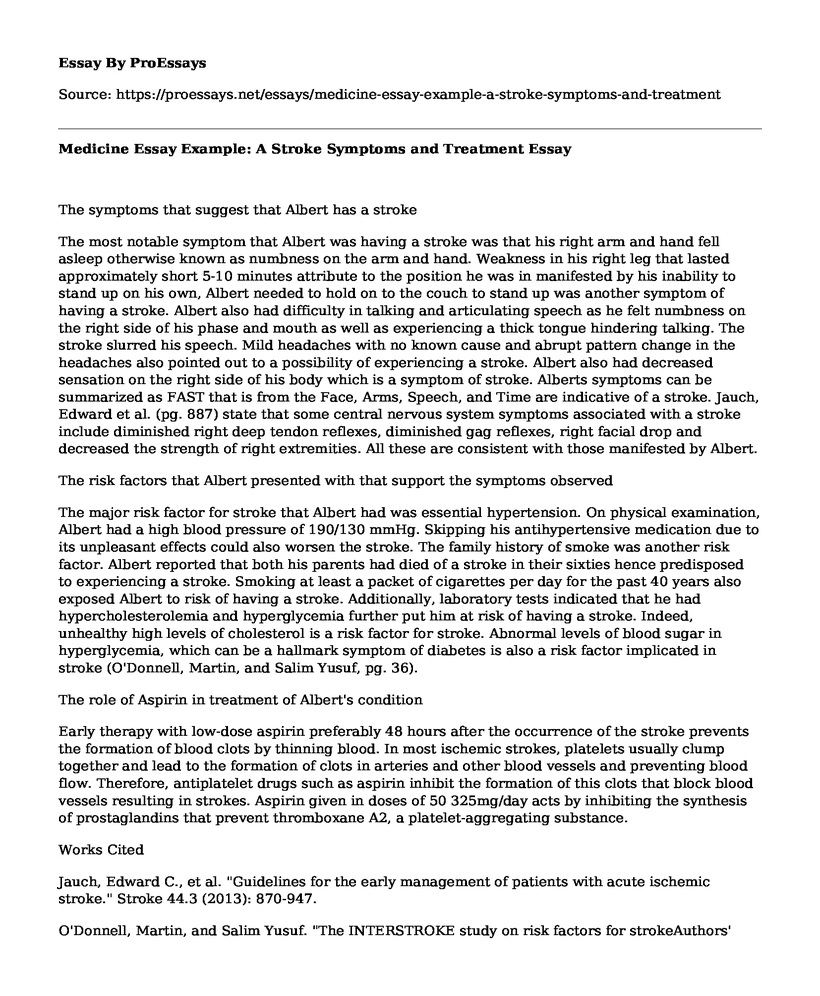The symptoms that suggest that Albert has a stroke
The most notable symptom that Albert was having a stroke was that his right arm and hand fell asleep otherwise known as numbness on the arm and hand. Weakness in his right leg that lasted approximately short 5-10 minutes attribute to the position he was in manifested by his inability to stand up on his own, Albert needed to hold on to the couch to stand up was another symptom of having a stroke. Albert also had difficulty in talking and articulating speech as he felt numbness on the right side of his phase and mouth as well as experiencing a thick tongue hindering talking. The stroke slurred his speech. Mild headaches with no known cause and abrupt pattern change in the headaches also pointed out to a possibility of experiencing a stroke. Albert also had decreased sensation on the right side of his body which is a symptom of stroke. Alberts symptoms can be summarized as FAST that is from the Face, Arms, Speech, and Time are indicative of a stroke. Jauch, Edward et al. (pg. 887) state that some central nervous system symptoms associated with a stroke include diminished right deep tendon reflexes, diminished gag reflexes, right facial drop and decreased the strength of right extremities. All these are consistent with those manifested by Albert.
The risk factors that Albert presented with that support the symptoms observed
The major risk factor for stroke that Albert had was essential hypertension. On physical examination, Albert had a high blood pressure of 190/130 mmHg. Skipping his antihypertensive medication due to its unpleasant effects could also worsen the stroke. The family history of smoke was another risk factor. Albert reported that both his parents had died of a stroke in their sixties hence predisposed to experiencing a stroke. Smoking at least a packet of cigarettes per day for the past 40 years also exposed Albert to risk of having a stroke. Additionally, laboratory tests indicated that he had hypercholesterolemia and hyperglycemia further put him at risk of having a stroke. Indeed, unhealthy high levels of cholesterol is a risk factor for stroke. Abnormal levels of blood sugar in hyperglycemia, which can be a hallmark symptom of diabetes is also a risk factor implicated in stroke (O'Donnell, Martin, and Salim Yusuf, pg. 36).
The role of Aspirin in treatment of Albert's condition
Early therapy with low-dose aspirin preferably 48 hours after the occurrence of the stroke prevents the formation of blood clots by thinning blood. In most ischemic strokes, platelets usually clump together and lead to the formation of clots in arteries and other blood vessels and preventing blood flow. Therefore, antiplatelet drugs such as aspirin inhibit the formation of this clots that block blood vessels resulting in strokes. Aspirin given in doses of 50 325mg/day acts by inhibiting the synthesis of prostaglandins that prevent thromboxane A2, a platelet-aggregating substance.
Works Cited
Jauch, Edward C., et al. "Guidelines for the early management of patients with acute ischemic stroke." Stroke 44.3 (2013): 870-947.
O'Donnell, Martin, and Salim Yusuf. "The INTERSTROKE study on risk factors for strokeAuthors' reply." The Lancet 389.10064 (2017): 36.
Cite this page
Medicine Essay Example: A Stroke Symptoms and Treatment. (2021, Apr 12). Retrieved from https://proessays.net/essays/medicine-essay-example-a-stroke-symptoms-and-treatment
If you are the original author of this essay and no longer wish to have it published on the ProEssays website, please click below to request its removal:
- Nursing Paper Sample: Nursing Care Models
- Investigating Causes of an Unknown Disease - Essay Sample
- Essay Sample on Non-Communicable Diseases: Threat to Travellers & Developing Nations
- Brain Development: Exploring Neuroimaging Technologies
- Fair Pricing for Pharmaceuticals: Balancing Profits and Health Outcomes - Essay Sample
- Essay on New Insights Into Leprosy: Implications for Treatment and Disease Control
- Essay Example on Nursing Student's First Hospital Clinical: Expectations, Confidence, and Vital Signs







